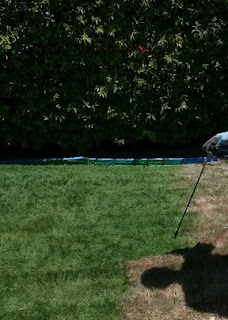Did you know you can spray your lawn green if it gets
scorched in the sun ?
It’s not something we think about doing in Inishowen as our
lawns don’t really suffer too much in dry weather and do stay greenish even in
the driest of spells. True, this could be due to an excess of moss, but they’re
still green.
The same can’t be said of some American states where it’s
actually the law to keep your grass green. This is made difficult due to the
water shortages and restrictions, especially in highly populated areas such as
California.
Hence the rise of the garden spray painting companies.
 They’ll come along, get their knapsack sprayer out and with
a lance similar to a pressure washer cover all the grass with a green powdery
liquid which when dry can keep the lawn green for up to three months.
They’ll come along, get their knapsack sprayer out and with
a lance similar to a pressure washer cover all the grass with a green powdery
liquid which when dry can keep the lawn green for up to three months.
The paint used is mostly made from natural plant based green
dye and mixed with a clay called Kaolinite which is a silicate material and
sticks to the grass leaves when dry. You can make your own solution from Epsom
salts, fertilizer and food colouring but I wouldn’t recommend it as it could
poison the ground and doesn’t work as well.
Kaolinite is found in loads of our daily items such as
porcelain, toothpaste, cosmetics and paint. It’s also used as an organic crop
spray to deter insects and stop our apples getting sun scorched so we are well
used to it in our daily lives.
The grass paint won’t discriminate from covering any surface
though, so you have to mask off anything you don’t want turning a chlorophyll
green colour, your house, pathways, cars, dog and yourself will need
protecting.
The grass will still need a bit of care though even though
it looks healthy and this could be forgotten. Golf courses and amenity areas
have been touching up brown patches like this for years, now whole lawns are
being done.
There are suggestions that the idea of lawns is a dated
concept and they just don’t keep green like they used to now areas are becoming
hotter and dryer. They are not a viable option for residential areas that have
long periods of drought.
I actually don’t mind grass looking parched in summer as
it’s an indication of a pleasant, warm, dry spell after which the grass will
green up again when it rains. Others in
hotter climates see it as a signal that we need to start addressing the wider,
more important crisis of climate change instead of applying a thin veil over
the issue with paint.
Rhododendron Care
I’m often asked about pruning rhododendrons. There seems to
a resistance to cut them back leading to them getting out of control, but if
you treat them just like a regular shrub they can be kept in check.
We’ve had a wonderful display of flowers this year from both
garden and wild rhododendrons and unlike the wild ones which can take over
whole woodlands we can do something about the ones in our gardens.
 Generally it’s a wise idea to plant shrubs in areas where
they won’t get too big for their space. You can get smaller growing rhodo’s and
also azaleas which are in the same family but more than likely you have a
whopping shrub just waiting to take over the garden and make its way into the
house.
Generally it’s a wise idea to plant shrubs in areas where
they won’t get too big for their space. You can get smaller growing rhodo’s and
also azaleas which are in the same family but more than likely you have a
whopping shrub just waiting to take over the garden and make its way into the
house.
Pruning is more of an art form that a science and there’s no
hard and fast rule, it all depends on how you want the shrub to look and behave.
If you just need to deadhead the shrub then all it takes it to either snap off
the old flowerheads after the petals drop or cut back the stem until the end of
the flower stalk.
If you need a more drastic reduction in size you can work on
a three year plan of taking out all the old dead/weak wood, then cutting back
in stages where it’s not so much of a shock to the plant.
One year I worked at St Columb’s park house in Derry
removing the invasive rhododendrons that had gone really leggy. We unceremoniously
cut hundreds of them down to ground level in one winter. They have all survived
and grown back again, looking healthy and compact.
They are a hardy shrub and in the wild they are used to
being burnt to the ground and rejuvenating themselves all the stronger for it.
After flowering has finished is a great time to reduce the
plants in size and if you do it in stages there will always be flowers in the
following year.
